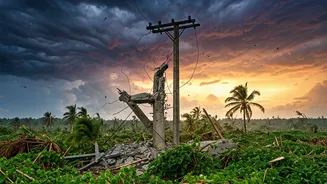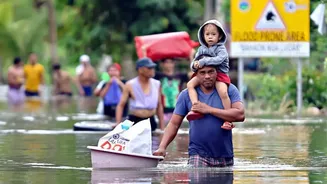Fung-wong's Arrival
Super Typhoon Fung-wong unleashed its fury upon the Philippines, marking a significant weather event. The typhoon was characterized by its immense strength,
bringing with it torrential rain and fierce winds that battered various regions. This caused widespread disruption, influencing daily routines and operations. Infrastructure, including power lines and communication networks, suffered damage, impacting many communities. The storm’s arrival presented immediate challenges, necessitating rapid responses to safeguard the population and alleviate the impact of the storm.
Impact Assessment Details
The initial assessments following the passage of Typhoon Fung-wong highlighted the scope of its impact. Although the primary concern during such events is always the loss of life, the fortunate outcome of this particular typhoon was the reported absence of any fatalities. This was a testament to the effectiveness of the preparedness measures. Despite this positive outcome, the typhoon’s force still brought about considerable damage to infrastructure. Buildings and other physical structures sustained various degrees of harm due to the ferocious winds and relentless rainfall. Communication and power supplies also experienced interruptions. This affected the daily lives of citizens and the operational capabilities of critical services.
Preparedness Measures' Success
A significant factor contributing to the positive outcome, with no fatalities, was the implementation of thorough preparedness measures. These measures included early warnings and public awareness campaigns. These campaigns were crucial in informing the public about the impending risks. They also provided guidance on how to stay safe. Evacuations were also carried out in high-risk areas. The proactive approach, combined with the cooperation of local communities, proved critical in lessening the potential impact of Fung-wong. The absence of fatalities served as a validation of these preemptive strategies, highlighting the importance of efficient disaster management protocols. This approach highlighted how being prepared and working together helps in times of severe weather.
Looking Forward to Recovery
Following the passage of Super Typhoon Fung-wong, the focus immediately turned to recovery and restoration efforts. Teams began working to assess the full extent of the damage. This assessment was essential to define the needs of the affected regions. Restoration projects included the repairing of infrastructure such as restoring power and communication lines. Furthermore, programs were put in place to assist the affected communities. This included the provision of essential resources like food, water, and shelter. The coordinated recovery actions also included initiatives to help residents to restore their daily lives and regain a sense of normalcy. The overall goal was to rebuild and improve the resilience of these communities in anticipation of future weather events.

















